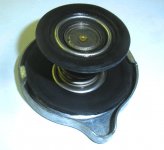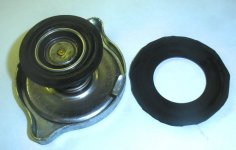Hi All,
Hate to pass up this discussion as I am always interested as to how Healeys are kept cool on a very hot day.
Many years ago I cam to the conclusion that the Healey’s cooling system was never sized properly to control operations in Hot summer temperatures. To address this issue of keeping cool, I did some investigation and found some interesting results. First, without a fan shroud, air leaks off the end of the fan blades and looses draw. Additionally, loss if air flow and direction is further thwarted by air passing around and under the radiator to form a high pressure block within the engine compartment. Some have installed fender vents or hood louvers to eliminate this air block and regain direction and flow through the engine compartment. However, for those that do not wish to cut their panels up, there are some easy approaches to gain proper air flow within the engine compartment and is explained in this article (
https://www.healey6.com/Technical/I always wanted a COOL Car.pdf).
By the way, although I have had a Texas Cooler over 10 years, I find the air draw good, but loud, when going slow or stopped. However, I find it a drag at speed. With the mods presented in the article, I have gone back to the original 4 blade Healey fan a couple of weeks ago to see if I really need the Texas Cooler. So far, I see no issue during 80 degree days but the real test will be during a traffic jam at the Jersey Shore when the weather is in the mid 90s.
By the way, as I understand, a thermostat controls the minimum engine operating temperature and, since the Healey cooling system is under configured for our hot weather, will do nothing to lower the engine’s operating temperature. Additionally, when not using a sleeved thermostat or some sort of recirculation block-out, on a hot day, your Healey’s cooling capacity will build to as much as a 25% capacity loss when this sizable amount of your coolant does not pass through the radiator.
Cool Man Cool,,,,its not just a frame of mind.
Ray (64BJ8P1)

 Hi Guest!
Hi Guest!

 smilie in place of the real @
smilie in place of the real @
 Pretty Please - add it to our Events forum(s) and add to the calendar! >>
Pretty Please - add it to our Events forum(s) and add to the calendar! >> 


